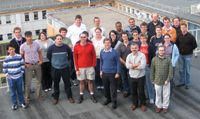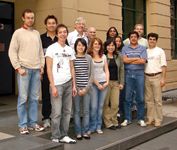The Wizards of Oz
Chromatography at the Australian Centre for Research on Separation Science (ACROSS), University of Tasmania; Chromatography at the Australian Wine Research Institute; Separation Science at the University of Western Sydney; Natural product analysis at Charles Sturt University; Chromatography at the Australian Centre for Research on Separation Science (ACROSS), RMIT
Chromatography at the Australian Centre for Research on Separation Science (ACROSS), University of Tasmania
ACROSS is a national research centre with nodes at the University of Tasmania and RMIT University. It comprises some 50 staff and students in total (with 30 of these in Tasmania) working in a range of structured research programmes based in the following areas: new separation media and materials; multidimensional and hyphenated systems; microfluidics and miniaturized separation technologies; detection and identification technologies; trace analysis and speciation; macromolecules and particles; theory, optimization and simulation of separation processes; and applications. Of these areas, the research on multidimensional separations is based largely at RMIT University (see report by Philip Marriott), so the following overview focuses on the remaining programmes. Full details on the structure, research programmes, performance, publications and job opportunities in ACROSS can be accessed from the website and copies of our annual reports can be downloaded.

Current research on stationary phases emphasizes the development of polymeric monolithic phases for use in microchips, capillaries and conventional HPLC and CEC columns. Many of these phases are ion-exchangers designed for ion chromatography (IC) and are synthesized by a patented approach of forming a functionalized template monolith and coating it with functionalized ion-exchange nanoparticles. Extensive research is also undertaken on modelling of retention behaviour and optimization of separation conditions. This has led to the development of commercial software for optimization of eluent composition in IC. Counter-terrorism research is another major feature of our activities. This involves the development of portable and field-deployable instrumentation for rapid pre- and postblast identification of homemade explosives for forensic and routine screening applications. Miniaturized detection systems form an important part of these studies. In the area of microfluidics, ACROSS researchers are designing chip-based systems for application in organic synthesis and analytical chemistry. Microreactors are applied for small-scale catalysis and sample clean-up and preconcentration are combined with separation and detection to form miniaturized total analysis systems (μTAS) with applications in both forensics and life sciences. Another of our programmes examines separation science as a means to speciate elements in open ocean waters, with the results making an important contribution to understanding climate change. Numerous applications of separation science are under development, ranging from methods for the analysis of gold thiosulphate leach solutions, to monitoring oil spills in Antarctica. Finally, a recent major expansion of ACROSS has occurred through a collaboration with Pfizer. This has resulted in the formation of the Pfizer Analytical Research Centre (PARC), which will investigate a wide range of projects involving the role of separation science in the pharmaceutical industry

ACROSS in Tasmania is very fortunate to have access to excellent modern laboratories (including a microfabrication facility), housing a wide range of state-of-the-art instrumentation, including HPLC, nano-HPLC, LC–MS, CE, CE–MS, IC, GC and GC–MS.
For more information, contact
Professor Paul Haddad paul.haddad@utas.edu.au
Chromatography at the Australian Wine Research Institute
Wine is a complex matrix. It is mostly water, followed by 10 –15% ethanol (typically) and up to 1% glycerol. However, the remaining fraction (< 0.1%) contains thousands of compounds, the minority of which are responsible for colour, aroma and flavour differences between wines. Some of the most important compounds are present only at trace levels. For example, 2 furanmethanethiol (common to red wines aged in toasted oak barrels) exhibits roast coffee aroma above a perception threshold of 0.4 ng/L (ppt).

Our challenge, as analytical chemists working on this difficult matrix, is to identify which compounds are of interest to wine aroma and flavour. Once identified, we are challenged to then extract and separate these target analytes from the many other compounds to accurately determine their concentrations. In such a way we are able to relate the composition of grapes and wine to their aroma and flavour. With this knowledge grapegrowing and winemaking conditions can be controlled better to make wine for specific target markets. This analytical approach has contributed to the Australian wine industry producing wines of quality and character that are in demand worldwide.

To target these trace compounds, and measure them accurately, we use three main approaches (often in combination):
1. Extraction and injection of the sample into the instrument: For volatile compounds, liquid–liquid extraction, solid-phase microextraction (SPME) or stir bar sorptive extraction (SBSE) (often in conjunction with headspace techniques) are useful.
2. Separation of compounds: GC is used extensively for volatile aroma and taint compounds. HPLC is used for heavier molecules (e.g., proteins, pigments and tannins).
3. Detection: Typically we use mass spectrometry (MS) as our detector of choice, for unparalleled confirmation of identity. It is also useful with co-eluting peaks to use selective ion monitoring. In conjunction with stable isotope dilution analyses (SIDA), GC–MS is a powerful quantitative technique for volatile compounds. Atomic emission detection (AED) is useful for element specific detection as applied effectively in our work on sulphur-containing compounds. For heavier molecules we usually use LC–MS or LC–UV–DAD (diode array detection). We have published extensively in the areas of method development and applications to measure aroma and flavour compounds (including those derived from grapes, fermentations or oak wood), and grape flavour precursor compounds, as well as taints, proteins, pigments and tannins.
For more information, contact
Dr Alan Pollnitz Alan.Pollnitz@awri.com.au
Separation Science at the University of Western Sydney
Our research is focused on high-resolution separations of complex sample mixtures using liquid chromatography. We study both analytical- and preparative-scale separations. To achieve our goal of high resolution we take a multifaceted approach to the separation process.

First, we aim to develop a molecular understanding of selectivity in separation. Our current projects in this area include molecular modelling of the stationary phase using our recently acquired SGI supercomputer. We use this information in the synthesis of new stationary phases, and then we systematically evaluate their surface chemistries. We undertake extensive studies to elucidate the retention process on these surfaces using test solutes appropriate to the type of stationary phase. Selectivity is evaluated using information theory and factor analysis, and measurement of thermodynamic parameters aids in the assessment of the retention mechanism.
Second, we study the packing of chromatography columns, with the aim of manufacturing more homogeneous beds.

Third, we apply the knowledge gained from the first two parts above to the application of multidimensional HPLC for the analysis and isolation of components in complex mixtures. We have two primary interests in this area of separation: comprehensive analysis of complex samples at the analytical scale, and targeted isolation of specific compounds in high yield and low cost using preparative-scale separations. Applications of both these processes are applied to both artificial model systems and complex natural products.
Our fourth area of interest is the study of flow heterogeneity within fluidized porous beds. Primarily, we investigate the phenomenon known as viscous fingering. Viscous fingering can occur in any liquid-phase chromatographic separation in which there is a mismatch in viscosity between the mobile phase and the injection plug. It is very important at the preparative level in which high sample concentrations lead to viscous injection plugs, and in multidimensional HPLC where solvent flow streams that can have very different viscosities are frequently transported between dimensions.
Our group works within the Nanoscale Organisation and Dynamics group (www.uws.edu.au/research/nano) and the Centre for Complementary Medicine (pubsites.uws.edu.au/complemed/), both at UWS.
For more information, contact
Dr Andrew Shalliker r.shalliker@uws.edu.au
Natural product analysis at Charles Sturt University
The major research interest of our metabolomics group at Charles Sturt University, Wagga Wagga, is the application of analytical science and, in particular, high-performance chromatography to problem-solving in complex systems, such as food and the environment. One focus is on natural products chemistry, particularly plant biophenols and other nutraceuticals. Biophenols and their associated activity have generated intense interest. The ability to measure biophenols and their associated activity is fundamental to any understanding of their biological function. High-performance separation is mandatory in any comprehensive analytical scheme because of the diversity of structures and limited precision and selectivity of quantification techniques. In a recent project we used LC coupled with photodiode array, fluorescence and electrospray ionization mass spectrometry to investigate optimizing olive oil quality from a given fruit input. In a related project, the olive mill waste (OMW) generated from olive processing has been examined for recovery of high-value nutraceuticals. Using a combination of bioactivity-guided fractionation and chemical screening, the waste was examined for approximately 100 chemicals that have been reported in olive products.

We were able to confirm the presence of approximately 50 biophenols in the waste, and the unique biophenolic profile of Australian olives using high-performance chromatography. Although olive fruit, oil and OMW were dominated by the same biophenolic classes, namely, secoiridoids, simple phenols and flavonoids, the biophenolic profile of the fruit and OMW were similar, but differed significantly from that of oil. This has important implications for bioactivity studies, which we are now undertaking.

For more information, contact
Professor Kevin Robards krobards@csu.edu.au
Chromatography at the Australian Centre for Research on Separation Science (ACROSS), RMIT
The RMIT University node of the Australian Centre for Research on Separation Science (ACROSS) specializes in volatile chemical analysis, although we have research programmes in capillary electrophoresis and HPLC.

Our chemical analysis tools focus primarily on comprehensive two-dimensional gas chromatography (GC×GC), which is an emerging method for high-resolution gas chromatographic separations. Since we developed a modulation interface — we call this the longitudinally modulated cryogenic system (LMCS) — that permits efficient trapping and rapid remobilization of volatile chemical compounds that enter the interface as they migrate in capillary GC columns, this interface has been the key technology that we have used to implement our (GC×GC) research. For further details of the GC×GC method, refer to our website. We presently have 7 GC×GC systems in our laboratory, all based on Agilent GCs. We are interested in specific detection technologies, and so included on these GCs are detectors such as the ECD, NPD and dual FIDs. High-resolution GC×GC separations produce peaks that are on the order of 100 ms wide, and so this requires fast data acquisition. However, equally important is the ability to identify either the target compounds in a sample, or give a broad interpretation to the complex chromatographic result. Hence mass spectrometry is an important enabling tool. We have both quadrupole and time-of-flight mass spectrometry detection systems (and soon, high-resolution TOFMS), interfaced to GC×GC. The former has limited scan speed, so may provide only 30+ scans per s, whilst low-resolution TOFMS is able to provide data acquisition rates of 100+ Hz. Our interest in aroma analysis is aided by an olfactory detector system.
In addition to GC×GC, we believe that our new approaches to fast multidimensional GC will also expand the tools available to researchers requiring increased resolving power.

We support our development of new research methods by fundamental studies such as new approaches to quantitative analysis using GC×GC, detector performance, and better understanding and optimization of GC×GC method implementation. But equally important are applications that demonstrate the way GC×GC offers new information to the analyst. Thus we have programmes in fatty acid methyl ester analysis, aroma/essential oils, pesticides/fungicides, petroleum products/biodiesel, atmospheric analysis, and methods for metabolomics and drugs profiling (including derivatisation techniques). We have collaborative programmes with many groups nationally and internationally, which have been mutually productive and rewarding.
For more information, contact
Professor Philip Marriott philip.marriott@rmit.edu.au

A Matrix-Matched Semiquantification Method for PFAS in AFFF-Contaminated Soil
Published: April 14th 2025 | Updated: April 14th 2025Catharina Capitain and Melanie Schüßler from the Faculty of Geosciences at the University of Tübingen, Tübingen, Germany describe a novel approach using matrix-matched semiquantification to investigate per- and polyfluoroalkyl substances (PFAS) in contaminated soil.
Silvia Radenkovic on Building Connections in the Scientific Community
April 11th 2025In the second part of our conversation with Silvia Radenkovic, she shares insights into her involvement in scientific organizations and offers advice for young scientists looking to engage more in scientific organizations.



















